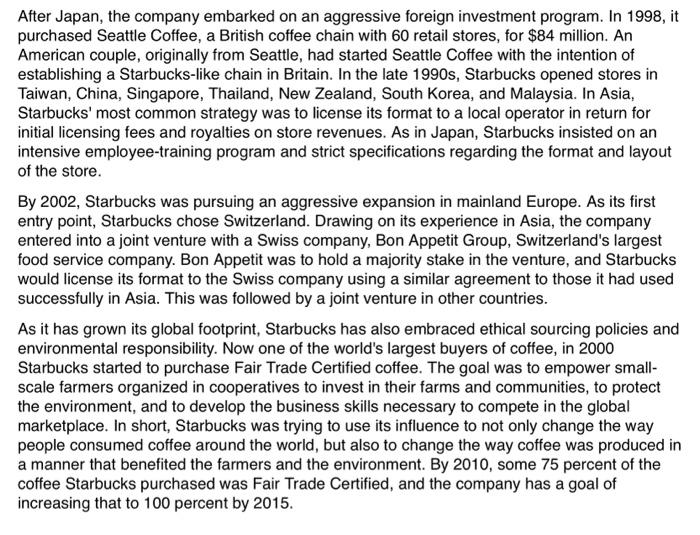This is is an industrial engineering assignment.
Objective: Upon completion of this activity, you will be able to describe how jobs can be made more interesting for workers and explain how worker performance can be tied to incentive pay. Student Instructions: Answer the following questions on the Discussion Forum. Read your classmates comments and write comments for at least two of your classmates' writings. The value of the Case Study is 100 points. The deadline for the questions can be found in "Tools" located in "Calendar" in the Blackboard platform. Read the case study and answer the following questions: 1. Where did the original idea for the Starbucks format come from? What lesson for international business can be drawn from this? 2. What drove Starbucks to start expanding internationally? How is the company creating value for its shareholders by pursuing an international expansion strategy? 3. Why do you think Starbucks decided to enter the Japanese market via a joint venture with a Japanese company? What lesson can you draw from this? 4. Is Starbucks a force for globalization? Explain your answer. 5. When it comes to purchasing coffee beans, Starbucks adheres to a "fair trade" program. What do you think is the difference between fair trade and free trade? How might a fairtrade policy benefit Starbucks? After Japan, the company embarked on an aggressive foreign investment program. In 1998 , it purchased Seattle Coffee, a British coffee chain with 60 retail stores, for $84 million. An American couple, originally from Seattle, had started Seattle Coffee with the intention of establishing a Starbucks-like chain in Britain. In the late 1990s, Starbucks opened stores in Taiwan, China, Singapore, Thailand, New Zealand, South Korea, and Malaysia. In Asia, Starbucks' most common strategy was to license its format to a local operator in return for initial licensing fees and royalties on store revenues. As in Japan, Starbucks insisted on an intensive employee-training program and strict specifications regarding the format and layout of the store. By 2002, Starbucks was pursuing an aggressive expansion in mainland Europe. As its first entry point, Starbucks chose Switzerland. Drawing on its experience in Asia, the company entered into a joint venture with a Swiss company, Bon Appetit Group, Switzerland's largest food service company. Bon Appetit was to hold a majority stake in the venture, and Starbucks would license its format to the Swiss company using a similar agreement to those it had used successfully in Asia. This was followed by a joint venture in other countries. As it has grown its global footprint, Starbucks has also embraced ethical sourcing policies and environmental responsibility. Now one of the world's largest buyers of coffee, in 2000 Starbucks started to purchase Fair Trade Certified coffee. The goal was to empower smallscale farmers organized in cooperatives to invest in their farms and communities, to protect the environment, and to develop the business skills necessary to compete in the global marketplace. In short, Starbucks was trying to use its influence to not only change the way people consumed coffee around the world, but also to change the way coffee was produced in a manner that benefited the farmers and the environment. By 2010, some 75 percent of the coffee Starbucks purchased was Fair Trade Certified, and the company has a goal of increasing that to 100 percent by 2015 . The Globalization of Starbucks Thirty years ago, Starbucks was a single store in Seattle's Pike Place Market selling premiumroasted coffee. Today it is a global roaster and retailer of coffee with some 16,700 stores, 40 percent of which are in 50 countries outside of the United States. Starbucks set out on its current course in the 1980s when the company's director of marketing, Howard Schultz, came back from a trip to Italy enchanted with the Italian coffeehouse experience. Schultz, who later became CEO, persuaded the company's owners to experiment with the coffeehouse format-and the Starbucks experience was born. The strategy was to sell the company's own premium roasted coffee and freshly brewed espresso-style coffee beverages, along with a variety of pastries, coffee accessories, teas, and other products, in a tastefully designed coffeehouse setting. The company focused on selling "a third-place experience," rather than just the coffee. The formula led to spectacular success in the United States, where Starbucks went from obscurity to one of the best-known brands in the country in a decade. Thanks to Starbucks, coffee stores became places for relaxation, chatting with friends, reading the newspaper, holding business meetings, or (more recently) browsing the web. In 1995, with 700 stores across the United States, Starbucks began exploring foreign opportunities. The first target market was Japan. The company established a joint venture with a local retailer, Sazaby Inc. Each company held a 50 percent stake in the venture, Starbucks Coffee of Japan. Starbucks initially invested $10 million in this venture, its first foreign direct investment. The Starbucks format was then licensed to the venture, which was charged with taking over responsibility for growing Starbucks' presence in Japan. To make sure the Japanese operations replicated the "Starbucks experience" in North America, Starbucks transferred some employees to the Japanese operation. The licensing agreement required all Japanese store managers and employees to attend training classes similar to those given to U.S. employees. The agreement also required that stores adhere to the design parameters established in the United States. In 2001, the company introduced a stock option plan for all Japanese employees, making it the first company in Japan to do so. Skeptics doubted that Starbucks would be able to replicate its North American success overseas, but by the end of 2009 Starbucks had some 850 stores and a profitable business in Japan









